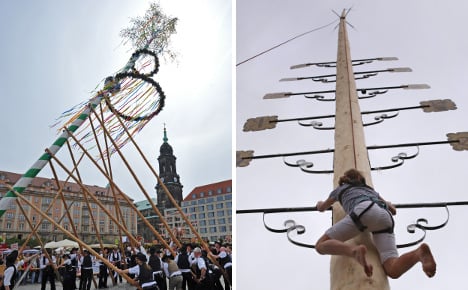1. Putting up (and stealing) the ‘May tree’
Similar to the maypole of Anglo traditions, the German Maibaum (May tree) is erected on May 1st or the day before. Residents in Bavaria, East Frisia in Lower Saxony, Baden-Württemberg and elsewhere celebrate this originally pagan ritual each year within their local communities.
The tree (or pole) is decorated with things like colourful streamers, flowers and in some places with scenes showing local crafts or activities.
Parades, brass band music and sausage-eating usually accompany the event of the actual raising of the tree. And don’t forget the special dark Maibock beer, brewed just for the occasion.
Perhaps the most thrilling part is the tradition of towns trying to steal one another’s May trees, requiring locals to keeps a close watch day and night to ward off their sneaky neighbours. If and when a tree is stolen, towns must then hash out a ransom for it, usually involving copious amounts of beer and food.
In 2004, some clever thieves used a helicopter to steal a May tree that had been placed atop Germany’s highest mountain, the Zugspitze.
READ ALSO: How small-town thieves took down Munich’s Goliath maypole
Advertisement
Another challenge in some areas is that people (the Maibaumkraxler in Bavaria) compete to climb the tree to get to the top as fast as possible.
2. Dancing until May comes
A Tanz in den Mai party in Dortmund. Photo: DPA.
Another tradition often associated with the May tree is Tanz in den Mai or dancing into May, starting on April 30th and not stopping until every one of your toes are aching.
But getting footloose on the eve of May 1st now also extends outside of the small town circles, with major clubs in big cities planning special events around the tradition. Since this year most Covid restrictions have been eased across Germany, you can except partying to be (almost) in full swing.
3. Partying with witches and devils
Celebrations of the ‘Witches’ Night’ in the Harz mountains. Photo: DPA.
The dancing tradition is also associated with Walpurgisnacht or Hexennacht (Witches’ Night), which also takes place on April 30th and into May 1st. Germanic folklore says witches would meet on the peak of Brocken within the Harz mountains to revel with the Devil.
To this day, women in the Harz area (and beyond) will dress up and go dance on the mountain top, warts, horns and all.
READ ALSO: Are you ready for Walpurgisnacht, Germany’s night of witches?
4. Jumping over fires
Another way to celebrate the witches’ night around May 1st is to light a bonfire, or Maifeuer, and jump over it, though in some regions this isn’t always connected to magical sorceresses. Plus we would not recommend trying it.
Advertisement
Other regions like Brandenburg light stick wooden figures of witches on fire to ward off any evil-doers.
5. Protesting (or perhaps partying)
A more modern tradition is to use the International Workers’ Day as a way to promote labour rights and for left-wingers to protest injustices.
Berlin’s Kreuzberg neighbourhood became a hotbed for such demonstrations in 1987, when riots there were so intense that police had to retreat from the area for hours.
Protests still carry on and sometimes get violent on this day, but there are also now alternative events in Kreuzberg that essentially turn the area into a massive street party, with musical performances, dance parties in Görlitzer Park and endless day-drinking.
READ ALSO: ‘Tag der Arbeit’: What to do on May 1st in Germany
Advertisement
6. Revealing a secret crush
If you’re having trouble finding the courage to tell your crush how you feel, May 1st might just be the perfect excuse for you to finally buck up and do it.
The Maistrich (May line) tradition involves drawing a line of chalk between the two lovers’ homes that sometimes crosses through town and ends in a heart, and/or with the pair’s names.
Another tradition related to the Maibaum is for young men go into the forest, chop down a young tree and place it outside the home of their love interest, often with decorations and her name on it.
Read More: World News | Entertainment News | Celeb News
Locals
